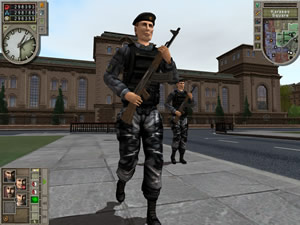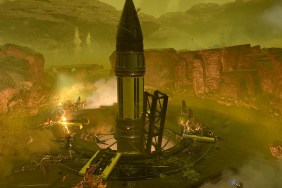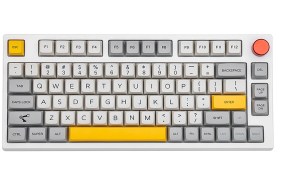The Revolution will not be televised.
Although most of you have probably never heard of it, Republic: The Revolution
has been lurking around the gaming industry for a very long time now. When it
was first unveiled at the E3 convention a few years ago, it even managed to garner
a few awards. But then the following year, it was still unfinished. Same thing
the year after that. Many of us simply assumed the game would actually never be
complete.
However, The
Revolution snuck up on us silently, like a sneaky fifth column, simply appearing
one day in the mail without fanfare. And while it tries some interesting new
gameplay ideas and subject matter, it’s a far cry from a revolutionary.
This particular grass-roots uprising takes place in that famous land of popular
revolutions… no, not Berkeley… Russia! Well, the former Soviet Union anyway.
When the Soviets pulled back out of Eastern Europe, they let loose a bunch of
little breakaway republics and brand new countries like Kyrgyzstan,
Turkmenistan,
and Kazakhstan. This
Republic happens to be in the Madeupistan of Novistrana.
As a young man, your parents are arrested by the fearsome head of the Secret Police, Vasily Karasov. They are never heard from again, and you vow revenge. But with the collapse of communism, Vasily seizes the opportunity and quickly establishes himself as the new President-for-life of Novistrana. Your revenge now requires nothing short of Revolution!
However, getting your revolution started is very tough, and I don’t mean just because you’re an average Joe with no political clout. It’s tough because you won’t be able to figure out how to do anything in the game. So put the revolution on pause and go read the manual for a while. This will help some, but is only the first slope on a very steep learning curve.
I recently complained that EVE Online
was the hardest game for new players I have ever seen. Well, the developers
over at Elixir must have taken my words as a challenge, because Republic
is a whole new level of hard-to-learn.
At least in EVE, while you may have been bewildered by the
complexity, you knew how to close a menu by clicking on the little X in the
upper right corner. Republic has the most opaque, unintuitive
control scheme imaginable. There are long-established, well-understood ways
to do things like opening and closing menus or moving the camera around; why
they thought it was a good idea to throw out all known conventions in favor
of their own confusing system of unexplained icons and obtuse right-clicks,
I’ll never know.
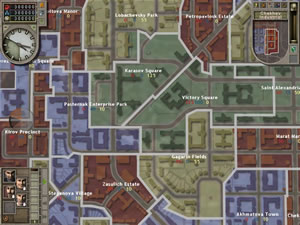 Republic
Republic
desperately needs a tutorial at the beginning and some fundamental interface
changes, but don’t expect any help except for some not-very-helpful stills with
little pointers telling you where your ‘Instigator Ideology’ indicator is. Too
bad you have no idea what that is. The manual also does a poor job of explaining
everything, but it’s all you have, so expect at least a couple hours of just
figuring out how to play the damn game. And expect to do it all over again if
you stop playing for a couple days or drink a few whiskies.
At least while you’re figuring everything out, Republic looks
good. There’s an amazing, fully functioning city to watch, with cars on the
road, shops, homes, apartments, restaurants, and people going about their daily
business (these are the people who will eventually see the light and join your
glorious uprising). You can follow any person around the city easily by simply
clicking on them, but trying to just move the camera around to get a good look
at the pretty graphics is very frustrating. There have been a number of complaints
about choppy performance on systems that just meet the minimum requirements,
but it runs and looks great on my machine.
The problem is that once you finally figure out how to play the game, you realize that most of the game takes place on the map screen and not in the pretty city view. The map screen has all the charts and info you need and is a much easier place in which to order around your little revolutionary henchmen.
Recruiting followers and sending them off on missions is what the game is all about. These “Actions” can be as boring as gathering information and distributing leaflets, or bolder moves like staging a demonstration, intimidating a rival, or bribing an official. Calling them “Actions” is a bit of a misnomer, since all you can do is watch, except that you won’t be watching because you’re busy on the map screen.
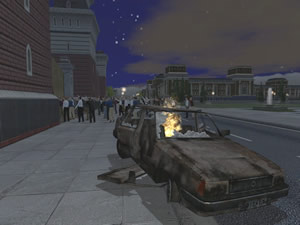 The game underneath
The game underneath
Republic‘s copious layers of confusion isn’t bad. The strategy
all boils down to a complex rock-paper-scissors game between Force, Wealth and
Influence. Wealth buys off Force, Influence taxes Wealth, and Force bitch-slaps
Influence, the pansy. You, your underground movement and your lieutenants all
have more or less of each of these traits, and each action you do costs a certain
amount of points. So the strategy lies in sending your henchman with a lot of
Wealth points to go deal with the rival thug with a lot of Force points.
In a major scenario like that, the game will switch to its conversation mini-game,
which is a bit like the trading card game Yu-Gi-Oh with the
same rock-paper-scissors idea. Each character has a number of conversational
choices to select, which cost different points and are tied to Force, Wealth,
or Influence. In the end, if your conversation “beats” his conversation, you
win.
These conversations all take place in the gibberish language of Novistrana, so the voice acting may or may not be good. It’s hard to tell. The music is simply terrific, an orchestral score with a decidedly Russian flair.
The events themselves are mixed between free-form events that you might or
might not see based on how you run your revolution and scripted events that
advance the larger plot. While the scripted events can lead to the more impressive
Tiananmen Square moments of
the game, they are also strictly linear and make the game less open and lower
the replay value.
Unfortunately, all the years and years of work on Republic: The Revolution
have produced a game that feels like it was never tested by actual players.
There are some great concepts here and the 3D cities are a truly impressive
piece of programming. Too bad all this originality is hidden deep behind one
of the worst game interfaces ever. Tolstoy fans might have the stubborn, unrelenting
determination required to get to the game underneath, but most of the proletariat
would be better off skipping this particular Revolution.
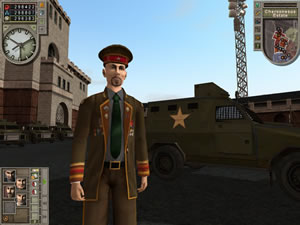
-
Original concepts
-
Decent strategy elements
-
Terrific music and graphics
-
That you won’t see much of
-
Badly needs a tutorial
-
Impossibly hard to learn
-
Worst interface ever
